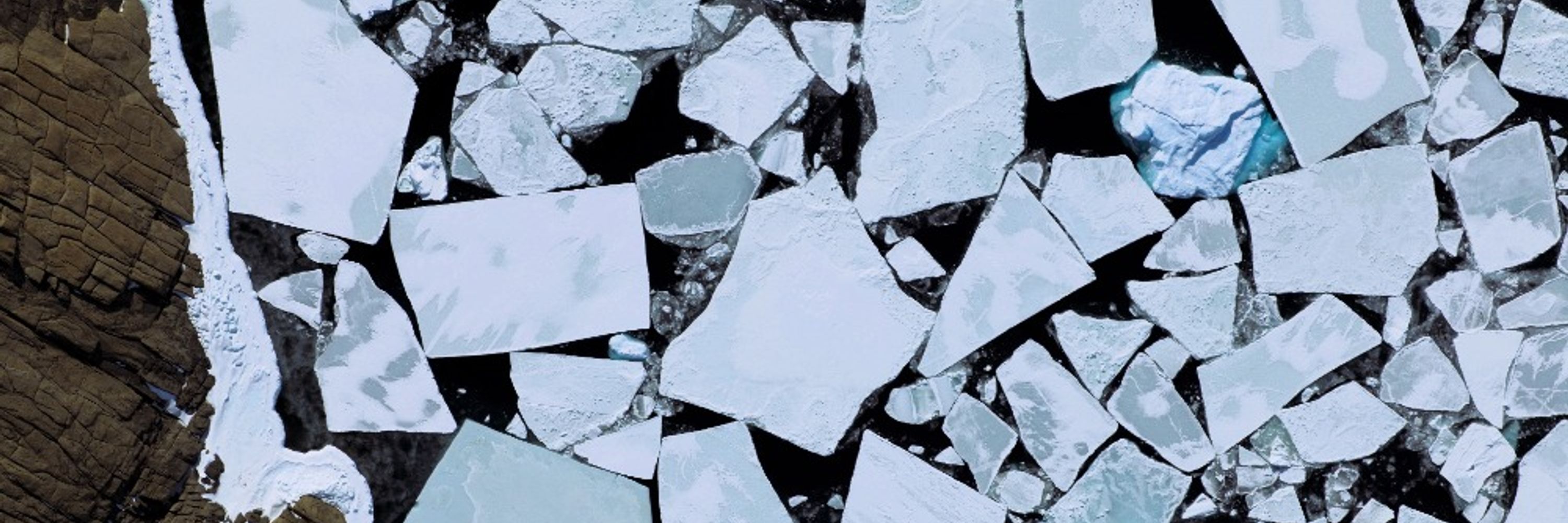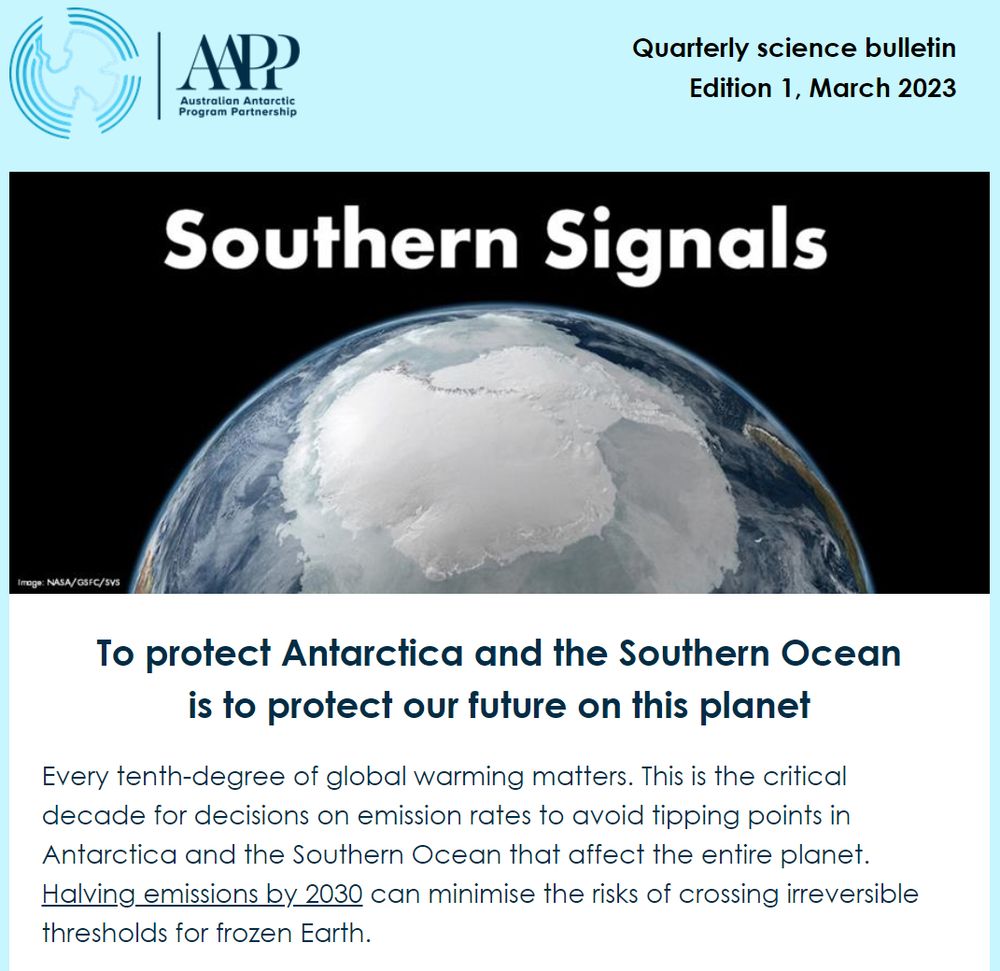
Australian Antarctic Program Partnership
@antarctic.bsky.social
To protect Antarctica and the Southern Ocean is to protect our future on this planet. In this critical decade for action, our science explores the role of the Antarctic region in the global climate system. Led by @utas.edu.au.
🔗 aappartnership.org.au
🔗 aappartnership.org.au
4/ “PACE offers us a once-in-a-generation opportunity to better understand how phytoplankton will respond to climate change, and what this means for nutrient and carbon cycling in the Southern Ocean.” — Dr Robert Strzepek, AAPP @imas-utas.bsky.social
🛰️ aappartnership.org.au/nasa-eye-in-...
🛰️ aappartnership.org.au/nasa-eye-in-...

November 11, 2025 at 3:15 AM
4/ “PACE offers us a once-in-a-generation opportunity to better understand how phytoplankton will respond to climate change, and what this means for nutrient and carbon cycling in the Southern Ocean.” — Dr Robert Strzepek, AAPP @imas-utas.bsky.social
🛰️ aappartnership.org.au/nasa-eye-in-...
🛰️ aappartnership.org.au/nasa-eye-in-...
3/ This year-long visualisation of PACE chlorophyll data shows areas with high chlorophyll concentration in red and yellow, medium chlorophyll in green and low chlorophyll in blue and purple. This covers one year, revealing the seasonal cycle of phytoplankton activity.
November 11, 2025 at 3:15 AM
3/ This year-long visualisation of PACE chlorophyll data shows areas with high chlorophyll concentration in red and yellow, medium chlorophyll in green and low chlorophyll in blue and purple. This covers one year, revealing the seasonal cycle of phytoplankton activity.
2/ Launched in 2024, PACE carries an advanced ocean colour sensor that detects green pigments like chlorophyll which reveal the community composition of microscopic plants known as phytoplankton. Here's an algal bloom in Bass Strait captured by PACE in 2024.

November 11, 2025 at 3:15 AM
2/ Launched in 2024, PACE carries an advanced ocean colour sensor that detects green pigments like chlorophyll which reveal the community composition of microscopic plants known as phytoplankton. Here's an algal bloom in Bass Strait captured by PACE in 2024.
6/ This work provides a blueprint for more reliable habitat modelling in other poorly observed ecosystems. It also provides a quantitative framework that can inform marine protected area design, biodiversity monitoring, and policy decisions under climate change.

October 31, 2025 at 5:28 AM
6/ This work provides a blueprint for more reliable habitat modelling in other poorly observed ecosystems. It also provides a quantitative framework that can inform marine protected area design, biodiversity monitoring, and policy decisions under climate change.
5/ When environmental information about the Southern Ocean is sparse, ocean models can help close the data gap. But since models are a simplification of reality, can we trust them? These results show that we can, but only if the ocean model is good at representing the Southern Ocean environment.

October 31, 2025 at 5:28 AM
5/ When environmental information about the Southern Ocean is sparse, ocean models can help close the data gap. But since models are a simplification of reality, can we trust them? These results show that we can, but only if the ocean model is good at representing the Southern Ocean environment.
4/ Sea ice (e.g. concentration, thickness, long-term presence) also features as a key environmental variable used as predictors for crabeater seal distribution in East Antarctica.

October 31, 2025 at 5:28 AM
4/ Sea ice (e.g. concentration, thickness, long-term presence) also features as a key environmental variable used as predictors for crabeater seal distribution in East Antarctica.
3/ Fun fact: despite their name, crabeater seals are experts at eating krill. Their love for krill shows in their teeth, which are beautifully modified for sieving krill from seawater. So perhaps not surprisingly, the distribution of Antarctic krill is a key driver of crabeater seal distribution.

October 31, 2025 at 5:28 AM
3/ Fun fact: despite their name, crabeater seals are experts at eating krill. Their love for krill shows in their teeth, which are beautifully modified for sieving krill from seawater. So perhaps not surprisingly, the distribution of Antarctic krill is a key driver of crabeater seal distribution.
2/ New research in @meps-ir.bsky.social takes a ‘big data’ approach, testing whether Species Distribution Models can accurately predict where crabeater seals are in East Antarctica.
▶️ doi.org/10.3354/meps...
@imas-utas.bsky.social @corneystuart.bsky.social
ARC Climate Extremes; AAD; JAMSTEC
▶️ doi.org/10.3354/meps...
@imas-utas.bsky.social @corneystuart.bsky.social
ARC Climate Extremes; AAD; JAMSTEC
High-resolution ocean sea ice model outputs to predict species distribution: case study of crabeater seal Lobodon carcinophagus in East Antarctica
Species distribution models (SDMs) quantify the relationship between species presence and environmental factors. They are often used to guide conservation management plans, but limited...
doi.org
October 31, 2025 at 5:28 AM
2/ New research in @meps-ir.bsky.social takes a ‘big data’ approach, testing whether Species Distribution Models can accurately predict where crabeater seals are in East Antarctica.
▶️ doi.org/10.3354/meps...
@imas-utas.bsky.social @corneystuart.bsky.social
ARC Climate Extremes; AAD; JAMSTEC
▶️ doi.org/10.3354/meps...
@imas-utas.bsky.social @corneystuart.bsky.social
ARC Climate Extremes; AAD; JAMSTEC
The latest issue of our quarterly science bulletin 'Southern Signals' dropped today. Please sign up at aappartnership.org.au/contact-us/ to receive yours by email.
You can read it at createsend.com/t/j-B016AC5A...
You can read it at createsend.com/t/j-B016AC5A...

October 31, 2025 at 2:56 AM
The latest issue of our quarterly science bulletin 'Southern Signals' dropped today. Please sign up at aappartnership.org.au/contact-us/ to receive yours by email.
You can read it at createsend.com/t/j-B016AC5A...
You can read it at createsend.com/t/j-B016AC5A...
2/ Now the IPCC @ipcc.bsky.social is seeking early-career researchers to apply as Chapter Scientists for the Seventh Assessment Report.
Applications close 18 October – www.ictp.it/opportunity/...
Applications close 18 October – www.ictp.it/opportunity/...
IPCC AR7 Chapter Scientists | ICTP
The Intergovernmental Panel on Climate Change (IPCC) is in the process of preparing its Seventh Assessment report (AR7). The IPCC Working Groups are seeking highly motivated early-career researchers f...
www.ictp.it
October 8, 2025 at 11:34 PM
2/ Now the IPCC @ipcc.bsky.social is seeking early-career researchers to apply as Chapter Scientists for the Seventh Assessment Report.
Applications close 18 October – www.ictp.it/opportunity/...
Applications close 18 October – www.ictp.it/opportunity/...


